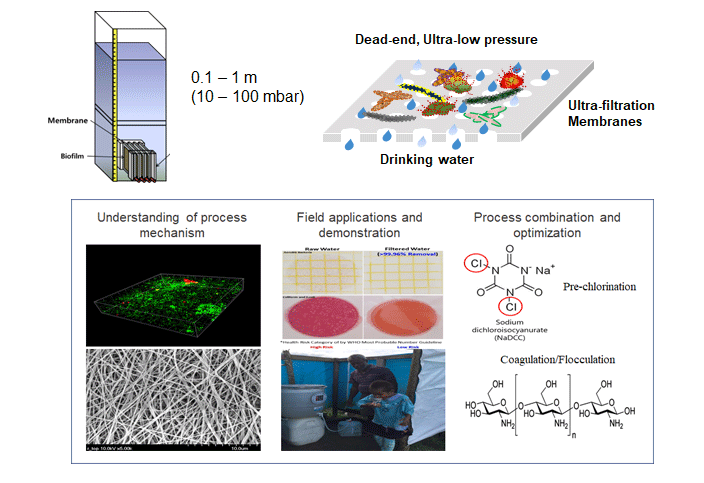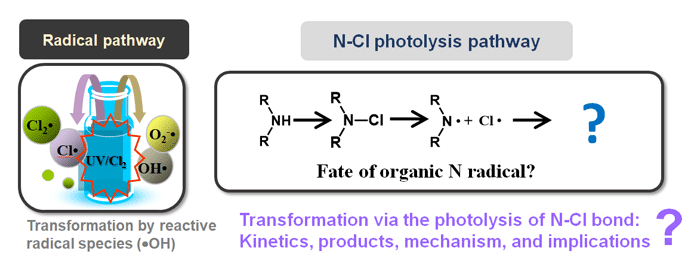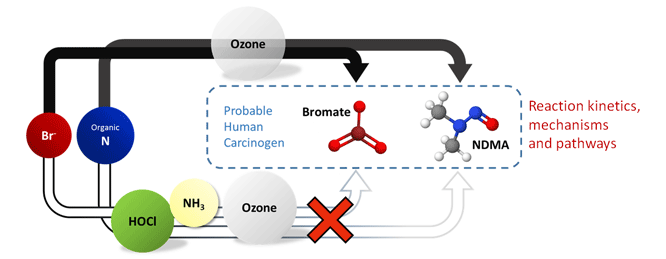Inactivation of antibiotic resistance bacteria & genes using disinfection processes
- Treatment efficiency for inactivation of ARGs during oxidative water treatment processes
- Identify the mode of action and kinetic model of antibiotic resistance genes and bacteria deactivation/inactivation
- Loss of transforming activity of ARG vs gene damages measured by qPCR
- Comparing Inactivation efficiency of intracellular vs. extracellular ARGs
- Application to wastewater treatment plant
Transformation of organic contaminants in oxidative water treatment processes : Structural identification, reaction mechanisms, and assessment of biological activity changes
- Oxidative water treatment processes (ozone, chlorine, ferrate etc)
- Identification and quantification of transformation products using a range of analytical methods including (ultra)high-resolution mass spectrometry
- Elucidation of reaction mechanisms and degradation pathways
- Assessment of biological activities changes (toxicity and biodegradability)
Ferrate(VI) applications for advanced municipal water treatment
- Oxidant/Disinfectant reactive to phenols, olefins, amines non-reactive to bromide
- Coagulant Fe(III)as a final product AsO4, PO4
- Kinetics and mechanisms for the reactions with oxidation kinetics and products of algal-derived taste & odor compounds
- Iodide and HOI : Implications for the fate of iodine and I-DBP control
- Oxidation of amine compounds : kinetics, products, and implications for N-DBP control
Development of gravity-driven membrane(GDM) filtration as a sustainable drinking water treatment technology
Transformation of organic nitrogen moieties in UV/chlorine
process:kinetics and mechanisms and implications for drinking water and industrial wastewater treatment
- Kinetics, products, and mechanisms for UV photolysis of various organic N-CI compounds
- Transformation of organic N moieties and implications for N-DBP formation control in drinking water quality engineering
- UV/chlorine AOP for treating recalcitrant DON-rich wasterwaters
Chemistry and roles of halogen radical species in UV-AOP processes
- Kinetics and mechanisms of formation and reaction of halogen radicals
- Formation of halogenated organic and oxyhalide byproducts
- Process modelling and optimization:UV/chlorine,UV/persulfate,AOPs in saline waters
Formation of toxic byproducts (nitrosamines and bromate) during ozonation of impaired water resources and development of formation control strategies
- Precursor identification and quantification in sewage effluents and impaired source aters
- Formation mechanisms elucidation and mitigation strategy development
- Demonstration of control strategies in laboratory-and pilot-scale studies
Precious metal recovery from e-waste
- Development of adsorbent for selective metal recovery
- Identify the adsorption kinetic and isotherm mode
- Mechanism of adsorption of metal ion to adsorbents
- Scale-up process for metal recovery
Removal of tritium from nulclear waste
- Develoment of materials for removal of tritium from water
- Identify the mechanism of removal of tritium from water
- Application to nuclear power plant
Biological monitoring and risk assessment of micropollutants in water environment

Application of Optimized Assays Using Sodium Biphenyl and Methylene Blue for Total PFAS Quantification in Water








